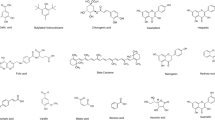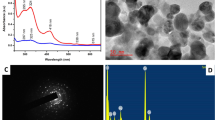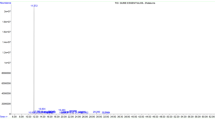Abstract
Re-occurrence of cancer is the major drawback for the currently available anticancer therapies. Therefore, study of an efficient enzyme, cholesterol oxidase produced by various kinds of microbes especially obtained from unexplored marine actinobacterial species against human cancer cell lines and understanding its mechanism of action helps to identify an irreversible and potent anticancer agent. The cytotoxic potential of cholesterol oxidase produced by a marine Streptomyces sp. AKHSS against four different human cancer cell lines was demonstrated through MTT [3-(4,5-dimethylthiazol-2-yl)-2,5-diphenyl tetrazolium bromide] assay. Fluorescent confocal microscopy and flow cytometry based experiments were performed to understand the efficiency of the enzymatic action on HeLa cells. Further, the apoptotic related proteins were detected through western blotting. Interestingly, the enzyme exhibited potent cytotoxicity at very low concentrations (0.093–0.327 µM) against all the cells tested. Fluorescent confocal microscopy revealed the morphological variations induced by the enzyme on cancer cell lines such as the formation of lipid droplets and condensation of nuclei. The enzyme treated cell-free extracts of HeLa cells analyzed through gas chromatography mass spectrometry showed the depletion of membrane cholesterol and the presence of substituted enzyme oxidized product, cholest-4-ene-3-one. The enzyme had induced significant inhibitory effects on the cell viability such as cell cycle arrest (G1 phase), apoptosis and rise of reactive oxygen species as evident through flow cytometry. Besides, hyperpolarization of mitochondrial membrane, reduced rates of phosphorylation of pAkt and the expression of apoptotic death markers like Fas, Fas L, caspases (8 and 3) and PARP-1 were recorded in the enzyme treated HeLa cells. Thus, cholesterol oxidase purified from a marine Streptomyces sp. AKHSS exhibits potent cytotoxicity at very low concentrations against human cancer cell lines. All the ex vivo experiments portrayed the substantial inhibitory effect of the enzyme on HeLa cells suggesting that cholesterol oxidase of Streptomyces sp. AKHSS could be a prominent cancer chemotherapeutic agent.
Graphic abstract












Similar content being viewed by others
References
Ahmad F, Sun Q, Patel D, Stommel JM (2019) Cholesterol metabolism: a potential therapeutic target in glioblastoma. Cancers 11:146
Altwairgi AK (2015) Statins are potential anti-cancerous agents (Review). Oncol Rep 33:1019–1039
Bajic´ A, Spasic´ M, Andjus PR, Savic´ D, Parabucki A, Nikolić-Kokić A, Spasojević I (2013) Fluctuating vs. continuous exposure to H2O2: the effects on mitochondrial membrane potential, intracellular calcium, and NF-kB in Astroglia. PLoS One 8:e76383
Beloribi-Djefaflia S, Vasseur S, Guillaumond F (2016) Lipid metabolic reprogramming in cancer cells. Oncogenesis 5:e189
Beskow LM (2016) Lessons from HeLa cells: the ethics and policy of biospecimens. Annu Rev Genom Hum Genet 17:395–417
Bienert GP, Schjoerring JK, Jahn PT (2006) Membrane transport of hydrogen peroxide. Biochim Biophys Acta 1758:994–1003
Boren J, Brindle KM (2012) Apoptosis-induced mitochondrial dysfunction causes cytoplasmic lipid droplet formation. Cell Death Differ 19:1561–1570
Broitman SA, Cerda S, Wilkinson J (1993) Cholesterol metabolism and colon cancer. Prog Food Nutr Sci 17:1–40
Brown AJ (2007) Cholesterol, statins and cancer. Clin Exp Pharmacol Physiol 34:135–141
Brzostek A, Dziadek B, Rumijowska-Galewicz A, Pawelczyk J, Dziadek J (2007) Cholesterol oxidase is required for virulence of Mycobacterium tuberculosis. FEMS Microbiol Lett 275:106–112
Cabodevilla AG, Sánchez-Caballero L, Nintou E, Boiadjieva VG, Picatoste F, Gubern A, Claro E (2013) Cell survival during complete nutrient deprivation depends on lipid droplet-fueled -oxidation of fatty acids. J Biol Chem 288:27777–27788
Chernov KG, Neuvonen M, Brock I, Ikonen E, Verkhusha VV (2017) Introducing inducible fluorescent split cholesterol oxidase to mammalian cells. J Biol Chem 292:8811–8822
Chimento A, Casaburi I, Avena P, Trotta F, De Luca A, Rago V, Pezzi V, Sirianni R (2019) Cholesterol and its metabolites in tumor growth: therapeutic potential of statins in cancer treatment. Front Endocrinol 9:807
Cruz ALS, Barreto EdA, Fazolini NPB, Viola JPB, Bozza PT (2020) Lipid droplets: platforms with multiple functions in cancer hallmarks. Cell Death Dis 11:105
Cruz PM, Mo H, McConathy WJ, Sabnis N, Lacko AG (2013) The role of cholesterol metabolism and cholesterol transport in carcinogenesis: a review of scientific findings, relevant to future cancer therapeutics. Front Pharmacol 4:119
Devi S, Kanwar SS (2017) Cholesterol oxidase: source, properties and applications. Insights Enzyme Res 1:5
Di Marzo N, Chisci E, Giovannoni R (2018) The role of hydrogen peroxide in redox-dependent signaling: homeostatic and pathological responses in mammalian cells. Cells 7:156
Dzbek J, Korzeniewski B (2008) Control over the contribution of the mitochondrial membrane potential (DeltaPsi) and proton gradient (DeltapH) to the proton motive force (Deltap). In silico studies. J Biol Chem 283:33232–33239
Elmore S (2007) Apoptosis: a review of programmed cell death. Toxicol Pathol 35:495–516
El-Naggar NElA, Soliman HM, El-Shweihy NM (2018) Extracellular cholesterol oxidase production by Streptomyces aegyptia, in vitro anticancer activities against rhabdomyosarcoma, breast cancer cell-lines and in vivo apoptosis. Sci Rep 8:2706
Fernandes P, Cruz A, Angelova B, Pinheiro HM, Cabral JMS (2003) Microbial conversion of steroid compounds: recent developments. Enzyme Microb Technol 32:688–705
Genicot G, Leroy JLMR, Donnay AV (2005) The use of a fluorescent dye, nile red, to evaluate the lipid content of single mammalian oocytes. Theriogenology 63:1181–1194
Gniadecki R (2004) Depletion of membrane cholesterol causes ligand-independent activation of Fas and apoptosis. Biochem Biophys Res Commun 320:165–169
Greenplate JT, Duck NB, Pershing JC, Purcell JP (1995) Cholesterol oxidase: an oöstatic and larvicidal agent active against the cotton boll weevil, Anthonomus grandi. Entomol Exp Appl 74:253–258
Guerra FS, Sampaio LdaS, Konig S, Bonamino M, Rossi MID, Costa ML, Fernandes P, Mermelstein C (2016) Membrane cholesterol depletion reduces breast tumor cell migration by a mechanism that involves non-canonical Wnt signaling and IL-10 secretion. Transl Med Commun 1:3
Hindler K, Cleeland CS, Rivera E, Collard CD (2006) The role of statins in cancer therapy. Oncologist 11:306–315
Hoque N, Hasan CM, Rana MdS, Varsha A, Sohrab MdH, Rahman KM (2018) Fusaproliferin, a fungal mycotoxin, shows cytotoxicity against pancreatic cancer cell lines. Molecules 23:3288
Hsiao CH, Yao CJ, Lai GM, Yang JS, Yu CS, Chiang JH, Lu CC, Yang ST, Yu CC, Chang SJ, Lin HY, Chung JG (2019) Honokiol induces apoptotic cell death by oxidative burst and mitochondrial hyperpolarization of bladder cancer cells. Exp Ther Med 17:4213–4222
Huang B, Song BI, Xu C (2020) Cholesterol metabolism in cancer: mechanisms and therapeutic opportunities. Nat Metab 2:132–141
Hunter T, Pines J (1994) Cyclins and cancer. II: cyclin D and CDK inhibitors come of age. Cell 79:573–582
Jahn KA, Su Y, Braet F (2011) Multifaceted nature of membrane microdomains in colorectal cancer. World J Gastroenterol 17:681–690
Jan R, Chaudhry GE (2019) Understanding apoptosis and apoptotic pathways targeted cancer therapeutics. Adv Pharm Bull 19:205–218
Kavitha A, Savithri HS (2020) Characterization of cholesterol oxidase from a marine Streptomyces sp. and its cytotoxicity. Process Biochem 89:175–185
Kreit J, Sampson NS (2009) Cholesterol oxidase: physiological functions. FEBS J 276:6844–6856
Li H, Feng Z, He ML (2020) Lipid metabolism alteration contributes to and maintains the properties of cancer stem cells. Theranostics 10:7053–7069
Li YC, Park MJ, Ye SK, Kim CW, Kim YN (2006) Elevated levels of cholesterol-rich lipid rafts in cancer cells are correlated with apoptosis sensitivity induced by cholesterol-depleting agents. Am J Pathol 168:1107–1118
Liang G, Sourav TS, Jodie T, Kaur M (2019) Targeting cellular cholesterol for anticancer therapy. FEBS J 286:4192–4208
Liemburg-Apers DC, Willems PHGM, Koopman WJH, Grefte S (2015) Interactions between mitochondrial reactive oxygen species and cellular glucose metabolism. Arch Toxicol 89:1209–1226
Liou GY, Storz P (2010) Reactive oxygen species in cancer. Free Radic Res 44:479–496
Liu J, Xian G, Li M, Zhang Y, Yang M, Yu Y, Lv H, Xuan S, Lin Y, Gao L (2014) Cholesterol oxidase from Bordetella species promotes irreversible cell apoptosis in lung adenocarcinoma by cholesterol oxidation. Cell Death Dis 5:e1372
Llaverias G, Danilo C, Mercier I, Daumer K, Capozza F, Williams TM, Sotgia F, Lisanti MP, Frank PG (2011) Role of cholesterol in the development and progression of breast cancer. Am J Pathol 178:402–412
Lolekha PH, Jantaveesirirat Y (1992) Streptomyces: a superior source for cholesterol oxidase used in serum cholesterol assay. J Clin Lab Anal 6:405–409
Luo X, Cheng C, Tan Z, Li N, Tang M, Yang L, Cao Y (2017) Emerging roles of lipid metabolism in cancer metastasis. Mol Cancer 16:76
Ma J, Fu G, Wu J, Han S, Zhang L, Yang M, Yu Y, Zhang M, Lin Y, Wang Y (2016) 4-cholesten-3-one suppresses lung adenocarcinoma metastasis by regulating translocation of HMGB1, HIF1α and Caveolin-1. Cell Death Dis 7:e2372
Mahesh H, Supriya VV, Chandagirikoppal VK, Hanumappa A, Doddakunche SP, Vidya G, Bibha C, Kanchugarakoppal SR, Sathees CR (2017) A benzothiazole derivative (5g) induces DNA damage and potent G2/M arrest in cancer cells. Sci Rep 7:2533
Marulla M, Valenza M, Leoni V, Caccia C, Scarlatti C, De Mario A, Zuccato C, Di Donato S, Carafoli E, Cattaneo E (2012) Pitfalls in the detection of cholesterol in Huntington’s disease models. PLOS Curr 4:e505886e9a1968
Matusewicz L, Meissner J, Toporkiewicz M, Sikorski AF (2015) The effect of statins on cancer cells—review. Tumour Biol 36:4889–4904
McDonnell DP, Park S, Goulet MT, Jasper J, Wardell SE, Chang CY, Norris JD, Guyton JR, Nelson E (2014) Obesity, cholesterol metabolism, and breast cancer pathogenesis. Cancer Res 74:4976–4982
Mendes MV, Recio E, Anton N, Guerra SM, Santos-Aberturas J, Martin JF, Aparicio JF (2007) Cholesterol oxidases act as signaling proteins for the biosynthesis of the polyene macrolide pimaricin. Chem Biol 14:279–290
Mills CC, Kolb EA, Sampson VB (2018) Development of chemotherapy with cell-cycle inhibitors for adult and pediatric cancer therapy. Cancer Res 78:320–325
Murad H, Hawat M, Ekhtiar A, AlJapawe A, Abbas A, Darwish H, Sbenati O, Ghannam A (2016) Induction of G1-phase cell cycle arrest and apoptosis pathway in MDA-MB-231 human breast cancer cells by sulfated polysaccharide extracted from Laurencia papillosa. Cancer Cell Int 16:39
Neuvonen M, Manna M, Mokkila S, Javanainen M, Rog T, Liu Z, Bittman R, Vattulainen I, Ikonen E (2014) Enzymatic oxidation of cholesterol: properties and functional effects of cholestenone in cell membranes. PLoS One 9:e103743
Otto T, Sicinski P (2017) Cell cycle proteins as promising targets in cancer therapy. Nat Rev Cancer 17:93–115
Pandey AK, Sassetti CM (2008) Mycobacterial persistence requires the utilization of host cholesterol. Proc Natl Acad Sci 105:4376–4380
Pelton K, Freeman MR, Solomon KR (2012) Cholesterol and prostate cancer. Curr Opin Pharmacol 12:751–759
Perillo B, Di Donato M, Pezone A, Di Zazzo E, Giovannelli P, Galasso G, Castoria G, Migliaccio A (2020) ROS in cancer therapy: the bright side of the moon. Exp Mol Med 52:192–203
Purcell JP, Greenplate JT, Jennings MG, Ryerse JS, Pershing JC, Sims SR, Prinsen MJ, Corbin DR, Tran M, Sammons RD, Stonard RJ (1993) Cholesterol oxidase: a potent insecticidal protein active against boll weevil larvae. Biochem Biophys Res Commun 196:1406–1413
Quintero M, Cabañas ME, Arús C (2007) A possible cellular explanation for the NMR-visible mobile lipid (ML) changes in cultured C6 glioma cells with growth. Biochim Biophys Acta 1771:31–44
Rodrigues dos Santos C, Fonseca I, Dias S, Mendes de Almeida JC (2014) Plasma level of LDL-cholesterol at diagnosis is a predictor factor of breast tumor progression. BMC Cancer 14:132
Schmitz JE, Kettunen MI, Hu D-E, Brindle KM (2005) 1H MRS-visible lipids accumulate during apoptosis of lymphoma cells in vitro and in vivo. Magn Reson Med 54:43–50
Schnitzler JG, Tiessens SJBMF, Bakker GJ, Dallinga-Thie GM, Groen AK, Nieuwdorp M, Stroes ESG, Kroon J (2017) Nile red quantifier: a novel and quantitative tool to study lipid accumulation in patient-derived circulating monocytes using confocal microscopy. J Lipid Res 58:2210–2219
Shankland SJ (1997) Cell-cycle control and renal disease. Kidney Int 52:294–308
Silvente-Poirot S, Poirot M (2012) Cholesterol metabolism and cancer: the good, the bad and the ugly. Curr Opin Pharmacol 12:673–676
Sivandzade F, Bhalerao A, Cucullo L (2019) Analysis of the mitochondrial membrane potential using the cationic JC-1 dye as a sensitive fluorescent probe. Bio Protoc 5:e3128
Smart EJ, Ying Y-S, Conrad PA, Anderson RGW (1994) Caveolin moves from caveolae to the Golgi apparatus in response to cholesterol oxidation. J Cell Biol 27:1185–1197
Spasojević I, Jones DR, Andrades MÉ (2012) Hydrogen peroxide in adaptation. Oxid Med Cell Longev (Article ID 596019) 2012:1–4
Szlasa W, Zendran I, Zalesinska A, Tarek M, Kulbacka J (2020) Lipid composition of the cancer cell membrane. J Bioenerg Biomembr 52:321–342
Szymonowicz K, Oeck S, Malewicz NM, Jendrossek V (2018) New insights into protein kinase B/Akt signaling: role of localized Akt activation and compartment-specific target proteins for the cellular radiation response. Cancers 10:78
Tecan Ultra Evolution, Technical note; http://universitaet-salzburg.ac.at/fileadmin/oracle_file_imports/28587.PDF
Trachootham D, Alexandre J, Huang P (2009) Targeting cancer cells by ROS-mediated mechanisms: a radical therapeutic approach? Nat Rev Drug Discov 8:579–591
Turfitt GE (1944) The microbiological degradation of steroids. Oxidation of cholesterol by Proactinomyces sp. J Biochem 38:49–62
Visweswaran M, Arfuso F, Warrier S, Dharmarajan A (2020) Aberrant lipid metabolism as an emerging therapeutic strategy to target cancer stem cells. Stem Cells 38:6–14
Vrielink A (2010) Cholesterol oxidase: structure and function. Subcell Biochem 51:137–158
Waring P, Mullbacher A (1999) Cell death induced by the Fas/Fas ligand pathway and its role in pathology. Immunol Cell Biol 77:312–317
Yang W, Bai Y, Xiong Y, Zhang J, Chen S, Zheng X, Meng X, Li L, Wang J, Xu C, Yan C, Wang L, Chang CCY, Chang TY, Zhang T, Zhou P, Song BL, Liu W, Sun SC, Liu X, Li B, Xu C (2016) Potentiating the antitumour response of CD8+ T cells by modulating cholesterol metabolism. Nature 531:651–655
Yang H, Villani RM, Wang H, Simpson MJ, Roberts MS, Tang M, Liang X (2018) The role of cellular reactive oxygen species in cancer chemotherapy. J Exp Clin Cancer Res 37:266
Yazdi MT, Zahraei M, Aghaepour K, Kamranpour N (2001) Purification and partial characterization of a cholesterol oxidase from Streptomyces fradiae. Enzyme Microb Technol 28:410–414
Yeh RD, Chen JC, Lai TY, Yang JS, Yu CS, Chiang JH, Lu CC, Yang ST, Yu CC, Chang SJ, Lin HY, Chung JG (2011) Gallic acid induces G0/G1 phase arrest and apoptosis in human leukemia HL-60 cells through inhibiting cyclin D and E, and activating mitochondria-dependent pathway. Anticancer Res 31:2821–2832
Zorova LD, Popkov VA, Plotnikov EY, Silachev DN, Pevzner IB, Jankauskas SS, Babenko VA, Zorov SD, Balakireva AV, Juhaszova M, Sollott SJ, Zorov DB (2018) Mitochondrial membrane potential. Anal Biochem 552:50–59
Acknowledgements
The authors acknowledge Dr. D.S. Kothari scheme, University Grants Commission, Pune, India for providing post doctoral fellowship (No.F.4-2/2006 (BSR)/BL/13-14/0327) to AK. HSS acknowledges INSA and NASI for senior scientist position. We acknowledge Department of Biotechnology and Department of Science and Technology, Government of India and Indian Institute of Science (IISc) for providing the facilities used in this study to the Department. AK acknowledges deeply the support she has received from the following faculty: Emeritus Prof. N. Appaji Rao, Prof. M.R.N. Murthy, Prof. Nagasuma Chandra, Prof. Anjali Anoop Karande, Prof. Satees C. Raghavan, Prof. Patrick D’ Silva and Prof. Purusharth I Rajyaguru. Extended thanks to Dr. Uttara Chakraborty and her team members (FACS facility, IISc), Dr. Vidya Gopalakrishnan and Mr. Murali (Gas Chromatography Mass Spectrometry facility, Division of Biological Sciences, IISc).
Funding
AK expresses her gratitude to Dr. D.S. Kothari scheme, University Grants Commission, Pune, India for providing post doctoral fellowship (No.F.4-2/2006 (BSR)/BL/13-14/0327). The work was also supported by J.C. Bose fellowship of HSS.
Author information
Authors and Affiliations
Contributions
The author (AK) planned, executed the whole work and wrote the manuscript while NASI scientist, HSS provided the laboratory support and funding for AK to perform her experiments and finally helped in the correction of the manuscript.
Corresponding author
Ethics declarations
Conflict of interest
The authors declare that they have no known competing financial interests or personal relationships that could have appeared to influence the work reported in this paper.
Ethical approval
This article does not contain any studies with human participants or animals performed by any one of the authors.
Additional information
Publisher's Note
Springer Nature remains neutral with regard to jurisdictional claims in published maps and institutional affiliations.
Rights and permissions
About this article
Cite this article
Alapati, K., Handanahal, S.S. Cytotoxic activity of cholesterol oxidase produced by Streptomyces sp. AKHSS against cancerous cell lines: mechanism of action in HeLa cells. World J Microbiol Biotechnol 37, 141 (2021). https://doi.org/10.1007/s11274-021-03076-5
Received:
Accepted:
Published:
DOI: https://doi.org/10.1007/s11274-021-03076-5




